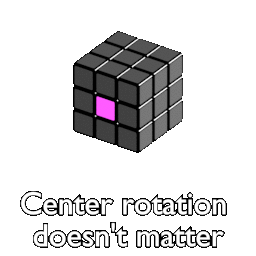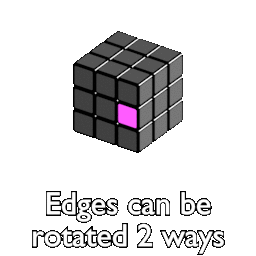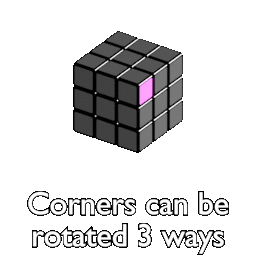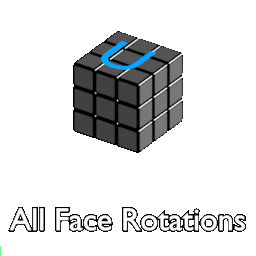Part 0: Introduction
Section 0-1: Fun Facts
- There are over 43 quintillion (that’s 43,000,000,000,000,000,000) possible combinations that a Rubik’s Cube can be scrambled into
- BUT no matter what, any scrambled cube can be solved in 20 moves or less (we won’t be learning that here though)
- The world record time for solving a Rubik's Cube is currently 3.47 seconds!
- The world record time for solving a Rubik's Cube blindfolded is currently 20.03 seconds!
Section 0-2: Helpful tips to keep in mind
- You're solving pieces, not stickers
- You have to put pieces in the right spot and in the correct rotation
- Centers can be rotated in any of their 4 orientations and still be solved since they only have 1 color fig. 1
- Centers never change position, they only rotate in place, so they’re good constant landmarks to keep an eye on when solving a cube
- Edges have 2 colors, so they can be rotated in 2 different orientations fig. 2
- Corners have 3 colors, so they can be rotated in 3 different orientations fig. 3
Section 0-3: Algorithm notation
- Rubik's Cubes can be solved using algorithms, which are essentially just step by step instructions that tell you what faces of the cube to turn to fix specific pieces without disturbing other areas of the cube
- In this tutorial we'll be learning the method known as beginner's method, but there are many more out there. Beginner's method isn't particularly fast if you're hoping to get into competitive speed cubing, but it's relatively simple to learn. For this tutorial, we only need to know 7 algorithms.
- Algorithm notation is a convenient way of succinctly writing out a series of rotations of faces of the cube that solve or otherwise manipulate specific pieces of the Rubik's Cube.
- In algorithm notation, each side is assigned a letter:
- Top face = U (up)
- Bottom face = D (down)
- Front face (the one facing you) = F
- Back face (the one facing away from you) = B
- Right face = R
- Left face = L
- Notation is relative to the way you're holding the cube at any given moment.
- Any face can be designated as U or R, depending on whether it's facing up or right at the moment, so the way you're holding the cube matters - it's all the difference between an algorithm solving part of the cube, or it completely undoing all your hard work so far.
- A letter on its own denotes rotating that face clockwise, as if you were looking at that face straight on (so a plain L or R will rotate in opposite directions from one another since they’re on opposite sides)
- A letter followed by an apostrophe (ex: B’) denotes rotating that face counterclockwise, as if you were looking at that face straight on
- A letter followed by a 2 (ex: F2) denotes turning that face 180 degrees. It does not matter which way the face is turned.
- See fig. 4 for examples of all face rotations and directions.
Move on to Part 1 ▶







